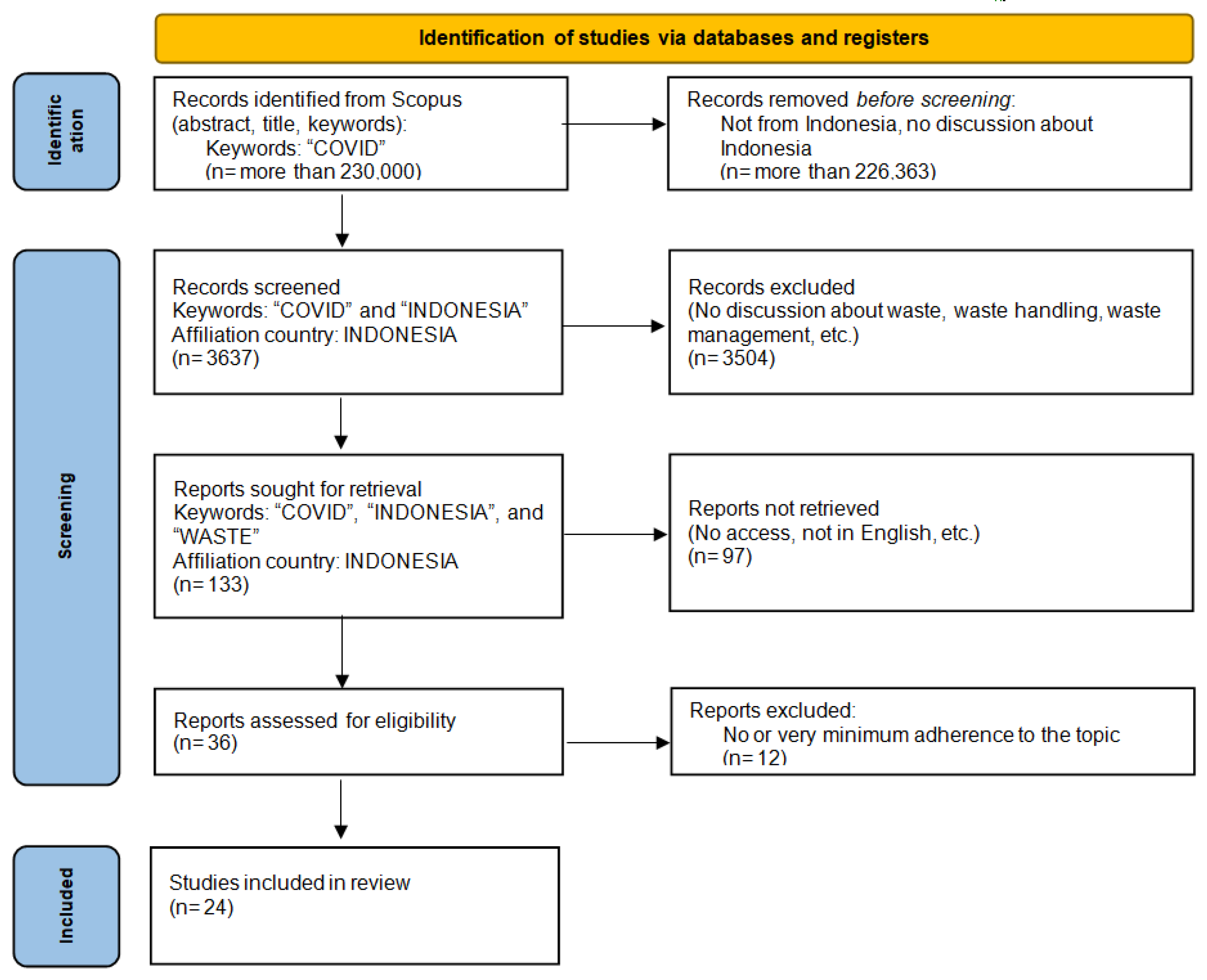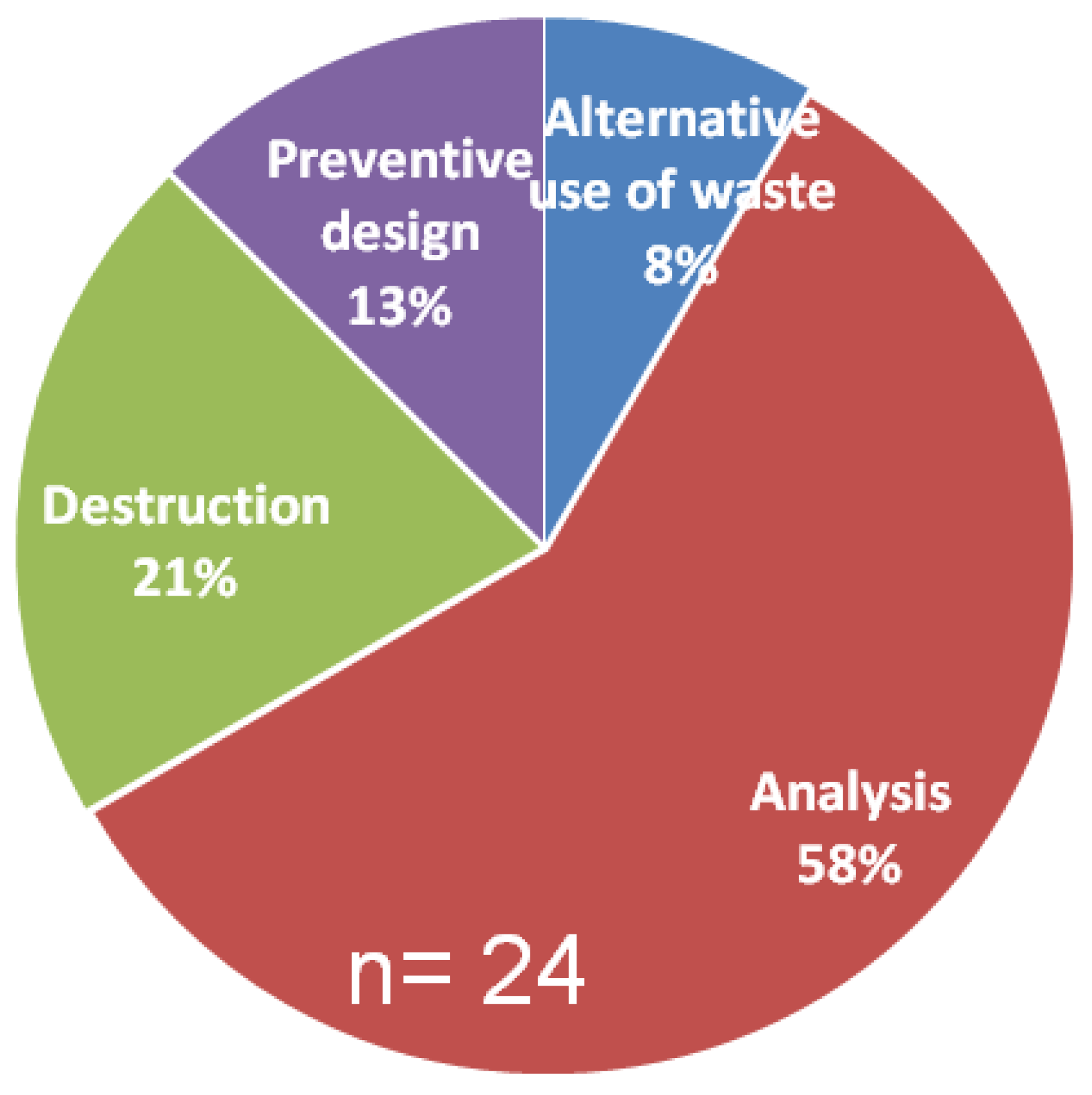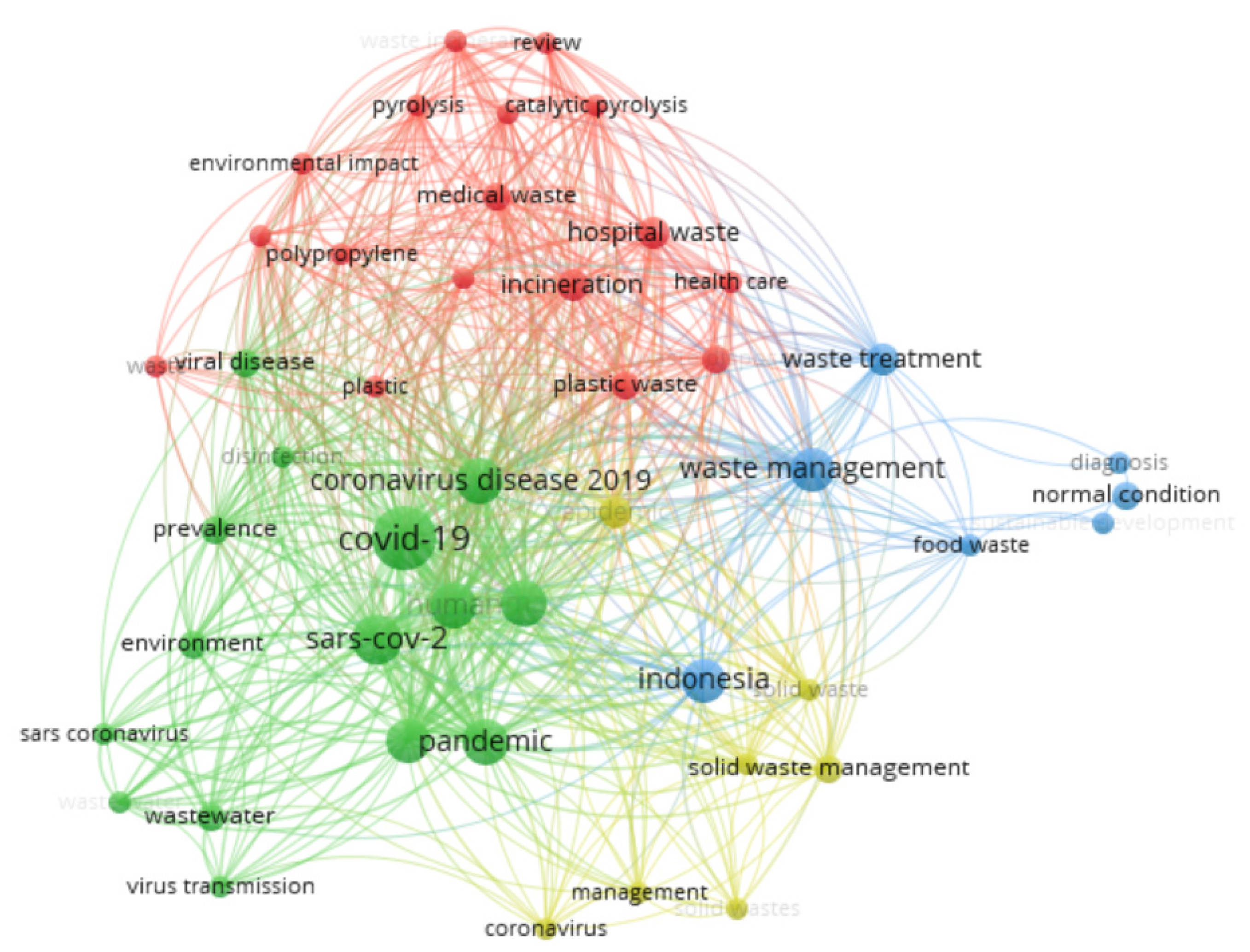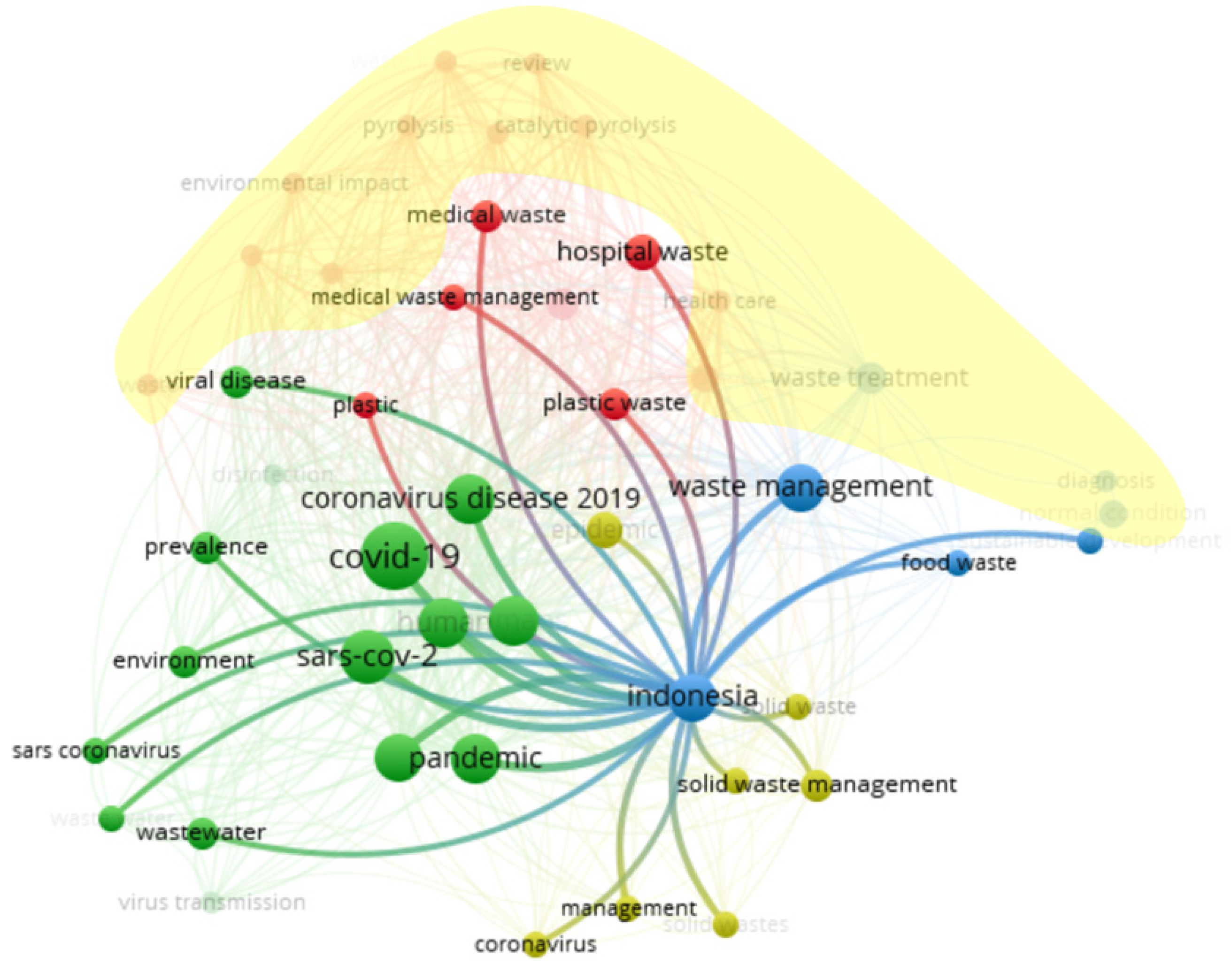Systematic Literature Review and Bibliometric Study of Waste Management in Indonesia in the COVID-19 Pandemic Era
Abstract
:1. Introduction
2. Materials and Methods
3. Results
3.1. Systematic Literature Review
| No. | Type(s) of Waste Handling | Type of Waste | Results | Ref. |
|---|---|---|---|---|
| 1. | Destruction | Coconut shell biomass waste with variations in the number of shells: 6, 8, 10, and 14 | Creation of biomass-based post-harvest technology innovations using the internet of things system | [13] |
| 2. | Destruction | Medical waste of personal protective equipment | Destruction of waste, preferably by using pyrolysis | [6] |
| 3. | Destruction | Plastic medical wastes (polyethylene, polypropylene, polystyrene, polyethylene terephthalate, and nylon) | Pyrolysis of waste (to produce energy products like oil, gas, and char) | [14] |
| 4. |
| Medical wastes (about 54,000 ton/day as of 22 November 2020), including face masks, gloves, clothes, goggles, and sanitizer/disinfectant | Thermochemical processes for waste processing, including incineration, torrefaction, pyrolysis, and gasification | [15] |
| 5. |
| Marine debris, diapers, organic wastes | Incineration (theoretical calculation of energy yield from incinerated waste) | [16] |
| 6. | Preventive design | Mask | Usage of AHP (analytic hierarchy process) for determining the appropriate material (quilting cotton, 600 TPI) for environmentally friendly non-medical mask | [17] |
| 7. | Preventive design | Medical waste | Preventive design of ergonomic and smart trash bin | [18] |
| 8. |
| Smart environment concept for smart cities ⟶ technological and social innovation approaches to improve medical and domestic waste management, public service systems, and the socialization of environmental protection programs | DKI Jakarta province:
| [19] |
| 9. | Alternative use of waste | Plastic waste and Electronic cable waste (e-waste) | Recycling of e-waste (plastic and cable) as a divider for cafes | [20] |
| 10. | Alternative use of waste | Tofu waste and tempeh waste, combined with microalgae Chlorella vulgaris | Alternative use of organic waste as a feed for goats to produce goat milk for COVID-19 | [21] |
| 11. |
| Face mask | Profile of face mask user, with 266 respondents, 79.3% wear reusable masks, 24.8% choose wrong/inappropriate material, 19.5% do not wash the reusable material, and some still dispose the masks mixed with domestic waste. | [22] |
| 12. | Analysis | General waste | Socioeconomic analysis of the waste bank closed-loop system in Surabaya City. | [5] |
| 13. |
| Food waste and stale food in restaurants, bars, and hotels | Profile of visitors to food and beverage locations during COVID-19 (500 respondents, 52% never visit bars, restaurants, hotels, where this condition might generate uncertainty in the F&B industry, hence more food waste and stale foods) | [23] |
| 14. | Analysis | Medical waste |
| [3] |
| 15. | Analysis | Medical mask | Microbiome analysis of mask waste—there are 47% coliform, 20% pathogen microbes, and 33% uncharacterized microbes | [25] |
| 16. | Analysis | Medical mask | ORF1 gene as a gene marker for rapid screening of mask waste treatment | [26] |
| 17. | Analysis | Used personal protective equipment (PPE, facemasks, gloves, and other protective items) | Analysis of possibilities for treating used PPE: co-disposal in a municipal solid waste incinerator, cement kilns, industrial furnaces, and deep burial | [24] |
| 18. | Analysis | PPE (medical masks, gloves, hazard suits, face shields, raincoats) |
| [4] |
| 19. | Analysis | Hazardous medical waste | Analysis of the challenges of handling hazardous medical waste using information technology (including regulation, technology, financial, and awareness) | [27] |
| 20. | Analysis | Sewage and wastewater | Analysis of COVID-19 virus in stools from sewage | [30] |
| 21. | Analysis | Wastewater | Proposed institutionalization of wastewater surveillance systems to monitor COVID-19 in wastewater | [31] |
| 22. | Analysis |
| Life cycle assessment (LCA) analysis to reveal the decrease in wastes. There are reductions of DOC (dissolved organic carbon) and methane and CO2 emission. | [32] |
| 23. | Analysis |
| Analysis using SNI 19-3964-1994 shows reduction of solid waste and air emissions during COVID-19 | [2] |
| 24. | Analysis | Sewage and wastewater | Review of coronavirus temperature dependence and survival in sewage water and recommendations for plumbing system for COVID-19 | [33] |
3.2. Bibiliometric Analysis
- Wastes and their treatments (red)
- COVID-19 (green)
- Indonesia and waste management (blue)
- Solid waste (yellow)
4. Future Recommendations
- Preventive design—this handling process is focusing on preventing and or minimizing waste generation by maximizing the potential use of resources.
- Alternative use of waste—this type of handling process goes beyond the recycling process to the use of upcycling (recycling with the addition of value).
5. Conclusions
Author Contributions
Funding
Institutional Review Board Statement
Informed Consent Statement
Data Availability Statement
Acknowledgments
Conflicts of Interest
Nomenclature
| AHP | analytic hierarchy process |
| CCTV | closed-circuit television |
| COVID-19 | coronavirus disease 2019 |
| DKI | Daerah Khusus Ibukota (special region for the national capital) |
| DOC | dissolved organic carbon |
| IoT | internet of things |
| LCA | life cycle analysis |
| PPE | personal protective equipment |
| PRISMA | preferred reporting items for systematic reviews and meta-analyses |
| SNI | standar nasional Indonesia (Indonesian National Standard) |
| TPI | twist per inch |
References
- Worldometer. COVID-19 Coronavirus Pandemic 2021. Available online: https://www.worldometers.info/coronavirus/ (accessed on 31 December 2021).
- Tassakka, M.I.S.; Musrianton, M.; Alsita, I.; Runtu, K.G.A.; Normayasari; Ndahawali, D.H. Modeling the impact of the COVID-19 pandemic on air emissions indicators of climate change originating from solid waste management in coastal settlements. IOP Conf. Ser. Earth Environ. Sci. 2020, 584, 012062. [Google Scholar] [CrossRef]
- Mahendradhata, Y.; Andayani, N.L.P.E.; Hasri, E.T.; Arifi, M.D.; Siahaan, R.G.M.; Solikha, D.A.; Ali, P.B. The Capacity of the Indonesian Healthcare System to Respond to COVID-19. Front. Public Health 2021, 9, 649819. [Google Scholar] [CrossRef] [PubMed]
- Cordova, M.R.; Nurhati, I.S.; Riani, E.; Nurhasanah; Iswari, M.Y. Unprecedented plastic-made personal protective equipment (PPE) debris in river outlets into Jakarta Bay during COVID-19 pandemic. Chemosphere 2021, 268, 129360. [Google Scholar] [CrossRef] [PubMed]
- Warmadewanthi, I.D.A.A.; Wulandari, D.; Cahyadi, M.N.; Pandebesie, E.S.; Anityasari, M.; Dwipayanti, N.M.U.; Purnama, I.G.H.; Nisaa, A.F. Socio-economic impacts of the COVID-19 pandemic on waste bank closed-loop system in Surabaya, Indonesia. Waste Manag. Res. 2021, 39, 1039–1047. [Google Scholar] [CrossRef] [PubMed]
- Muhjad, M.H.; Razy, F.; Hadin, A.F. The problematics of management personal protection equipment waste related to COVID-19 in indonesia. Sriwij. Law Rev. 2021, 5, 300–308. [Google Scholar] [CrossRef]
- Mangindaan, D.; Chen, C.-T.; Wang, M.-J. Integrating sol–gel with cold plasmas modified porous polycaprolactone membranes for the drug-release of silver-sulfadiazine and ketoprofen. Appl. Surf. Sci. 2012, 262, 114–119. [Google Scholar] [CrossRef]
- Mangindaan, D. Community Services in Indonesia Regarding Waste Handling and Management: Mapping and Bibliometric Analysis. Int. J. Community Serv. 2021, 1, 344–357. [Google Scholar]
- Agamuthu, P.; Barasarathi, J. Clinical waste management under COVID-19 scenario in Malaysia. Waste Manag. Res. 2021, 39, 18–26. [Google Scholar] [CrossRef]
- Kothari, R.; Sahab, S.; Singh, H.M.; Singh, R.P.; Singh, B.; Pathania, D.; Singh, A.; Yadav, S.; Allen, T.; Singh, S.; et al. COVID-19 and waste management in Indian scenario: Challenges and possible solutions. Environ. Sci. Pollut. Res. 2021, 28, 52702–52723. [Google Scholar] [CrossRef]
- Shammi, M.; Rahman, M.M.; Ali, M.L.; Khan, A.S.M.; Siddique, M.A.B.; Ashadudzaman, M.; Bodrud-Doza, M.; Alam, G.M.M.; Tareq, S.M. Application of short and rapid strategic environmental assessment (SEA) for biomedical waste management in Bangladesh. Case Stud. Chem. Environ. Eng. 2022, 5, 100177. [Google Scholar] [CrossRef]
- Baas, J.; Schotten, M.; Plume, A.; Côté, G.; Karimi, R. Scopus as a curated, high-quality bibliometric data source for academic research in quantitative science studies. Quant. Sci. Stud. 2020, 1, 377–386. [Google Scholar] [CrossRef]
- Muhammad, J.; Risanto, J.; Gimin. Temperature characteristics of post-harvest technology equipment based on biomass waste energy using the internet of things telecontrol system. J. Phys. Conf. Ser. 2021, 2049, 012023. [Google Scholar] [CrossRef]
- Dharmaraj, S.; Ashokkumar, V.; Pandiyan, R.; Halimatul Munawaroh, H.S.; Chew, K.W.; Chen, W.H.; Ngamcharussrivichai, C. Pyrolysis: An effective technique for degradation of COVID-19 medical wastes. Chemosphere 2021, 275, 130092. [Google Scholar] [CrossRef]
- Purnomo, C.W.; Kurniawan, W.; Aziz, M. Technological review on thermochemical conversion of COVID-19-related medical wastes. Resour. Conserv. Recycl. 2021, 167, 105429. [Google Scholar] [CrossRef] [PubMed]
- Suryawan, I.W.K.; Sarwono, A.; Septiariva, I.Y.; Lee, C.H. Evaluating marine debris trends and the potential of incineration in the context of the COVID-19 pandemic in Southern Bali, Indonesia. J. Ilm. Perikan. Dan Kelaut. 2021, 13, 70–78. [Google Scholar] [CrossRef]
- Hartanto, B.W.; Mayasari, D.S. Environmentally friendly non-medical mask: An attempt to reduce the environmental impact from used masks during COVID 19 pandemic. Sci. Total Environ. 2021, 760, 144143. [Google Scholar] [CrossRef]
- Joes, S.; De Candra, C.; Larsen, H.; Marchello, D.; Daywin, F.J.; Gozali, L.; Widodo, L.; Adianto, A.; Salomon, L.L.; Irawan, A.P. The design development of an ergonomic public trash bin for COVID-19 medical mask waste. In Proceedings of the International Conference on Industrial Engineering and Operations Management, Singapore, 7–9 March 2021; pp. 2756–2769. [Google Scholar]
- Rachmawati, R.; Mei, E.T.W.; Nurani, I.W.; Ghiffari, R.A.; Rohmah, A.A.; Sejati, M.A. Innovation in coping with the COVID-19 pandemic: The best practices from five smart cities in Indonesia. Sustainability 2021, 13, 12072. [Google Scholar] [CrossRef]
- Latif, F.; Chadijah, S.; Fanthi, R. Implementation of Reusable Plastic Waste and Electronic Cable Waste as Space Divider: Responding Sustainability Issue in New Normal Living-Study Case in a Small Coffee Shop. IOP Conf. Ser. Earth Environ. Sci. 2021, 794, 012154. [Google Scholar] [CrossRef]
- Sani, S.; Warly, L.; Zudri, F.; Novia, R.; Fadri, R.A. Chlorella vulgaris supplementation as mineral source of zinc and selenium to improve the quality of goat milk as health drink in COVID-19 pandemy. IOP Conf. Ser. Earth Environ. Sci. 2021, 757, 012051. [Google Scholar] [CrossRef]
- Prajitno, J.H.; Sulistiawati, F.K.; Caessario, J.; Sofyan, N.; Ari, B.; Putri, A.A.; Nureta, A.; Rafikasari, A.; Christi, L.; Farouq, H. The proper use of face mask during COVID-19 pandemic in urban community. Gac. Med. Caracas 2021, 129, S299–S304. [Google Scholar]
- De Leon, M.V.; Susilo, D.; Putranto, T.D.; Hartati, F.K.; Santos, R.R.T. Managing the uncertainty during COVID-19 pandemic: Communicating disaster and food industry sustainability. IOP Conf. Ser. Earth Environ. Sci. 2021, 819, 012039. [Google Scholar] [CrossRef]
- Hantoko, D.; Li, X.; Pariatamby, A.; Yoshikawa, K.; Horttanainen, M.; Yan, M. Challenges and practices on waste management and disposal during COVID-19 pandemic. J. Environ. Manag. 2021, 286, 112140. [Google Scholar] [CrossRef] [PubMed]
- Rozana, K.; Susanti, E.; Saputra, I.K.; Ciptawati, E.; Kurniawan, D.T. Microbiome analysis of medical mask waste as an early step to prevent environmental pollution due to unstandardized waste treatment strategies. IOP Conf. Ser. Earth Environ. Sci. 2021, 802, 012036. [Google Scholar] [CrossRef]
- Rozana, K. Orf 1 as a gene marker for fast screening in medical waste treatment applications during a COVID-19 pandemic. IOP Conf. Ser. Earth Environ. Sci. 2021, 802, 012037. [Google Scholar] [CrossRef]
- Rahayu, P.; Rohajawati, S.; Fairus, S.; Saragih, H.; Akbar, H. Challenges and Recommendation of the Information Technologies Application in Hazardous Medical Waste Management amidst Pandemic COVID-19. J. Phys. Conf. Ser. 2021, 1844, 012029. [Google Scholar] [CrossRef]
- Febrianto, G.; Karisma, D.; Mangindaan, D. Polyetherimide nanofiltration membranes modified by interfacial polymerization for treatment of textile dyes wastewater. IOP Conf. Ser. Mater. Sci. Eng. 2019, 622, 012019. [Google Scholar] [CrossRef]
- Karisma, D.; Febrianto, G.; Mangindaan, D. Polyetherimide thin film composite (PEI-TFC) membranes for nanofiltration treatment of dyes wastewater. IOP Conf. Ser. Earth Environ. Sci. 2018, 195, 012057. [Google Scholar] [CrossRef]
- Dhama, K.; Patel, S.K.; Yatoo, M.I.; Tiwari, R.; Sharun, K.; Dhama, J.; Natesan, S.; Malik, Y.S.; Singh, K.P.; Harapan, H. SARS-CoV-2 existence in sewage and wastewater: A global public health concern? J. Environ. Manag. 2021, 280, 111825. [Google Scholar] [CrossRef]
- Takeda, T.; Kitajima, M.; Huong, N.T.T.; Setiyawan, A.S.; Setiadi, T.; Hung, D.T.; Haramoto, E. Institutionalising wastewater surveillance systems to minimise the impact of COVID-19: Cases of Indonesia, Japan and Viet Nam. Water Sci. Technol. 2021, 83, 251–256. [Google Scholar] [CrossRef]
- Suryawan, I.W.K.; Rahman, A.; Septiariva, I.Y.; Suhardono, S.; Wijaya, I.M.W. Life Cycle Assessment of solid waste generation during and before pandemic of COVID-19 in Bali province. J. Sustain. Sci. Manag. 2021, 16, 11–21. [Google Scholar] [CrossRef]
- Zaid, S.; Aziz, M.A.; Sulaiman, R.; Simarani, K.; Suyoto, Y.T.; Lou, E.; Esfandiari, M. Review of coronavirus transmission in urban clusters: Survival in water and wastewater systems. J. Des. Built Environ. 2020, 20, 85–102. [Google Scholar] [CrossRef]




| No. | Label | Cluster | Weight |
|---|---|---|---|
| 1. | hospital waste | 1 | 33 |
| 2. | incineration | 1 | 33 |
| 3. | plastic waste | 1 | 31 |
| 4. | health care | 1 | 29 |
| 5. | medical waste | 1 | 29 |
| 6. | waste disposal | 1 | 29 |
| 7. | polypropylene | 1 | 28 |
| 8. | polypropylenes | 1 | 28 |
| 9. | medical waste management | 1 | 26 |
| 10. | catalytic pyrolysis | 1 | 25 |
| 11. | energy conversion | 1 | 25 |
| 12. | pyrolysis | 1 | 25 |
| 13. | review | 1 | 25 |
| 14. | waste incineration | 1 | 25 |
| 15. | environmental impact | 1 | 23 |
| 16. | plastic | 1 | 15 |
| 17. | waste | 1 | 15 |
| 18. | coronavirus disease 2019 | 2 | 42 |
| 19. | COVID-19 | 2 | 42 |
| 20. | human | 2 | 42 |
| 21. | humans | 2 | 42 |
| 22. | SARS-CoV-2 | 2 | 42 |
| 23. | pandemic | 2 | 37 |
| 24. | pandemics | 2 | 37 |
| 25. | prevalence | 2 | 31 |
| 26. | disinfection | 2 | 29 |
| 27. | viral disease | 2 | 28 |
| 28. | environment | 2 | 21 |
| 29. | wastewater | 2 | 16 |
| 30. | sars coronavirus | 2 | 15 |
| 31. | waste water | 2 | 15 |
| 32. | virus transmission | 2 | 14 |
| 33. | waste management | 3 | 38 |
| 34. | indonesia | 3 | 28 |
| 35. | waste treatment | 3 | 27 |
| 36. | food waste | 3 | 20 |
| 37. | diagnosis | 3 | 3 |
| 38. | normal condition | 3 | 3 |
| 39. | sustainable development | 3 | 3 |
| 40. | epidemic | 4 | 37 |
| 41. | government | 4 | 22 |
| 42. | solid waste | 4 | 22 |
| 43. | solid waste management | 4 | 22 |
| 44. | coronavirus | 4 | 17 |
| 45. | management | 4 | 16 |
| 46. | solid wastes | 4 | 15 |
Publisher’s Note: MDPI stays neutral with regard to jurisdictional claims in published maps and institutional affiliations. |
© 2022 by the authors. Licensee MDPI, Basel, Switzerland. This article is an open access article distributed under the terms and conditions of the Creative Commons Attribution (CC BY) license (https://creativecommons.org/licenses/by/4.0/).
Share and Cite
Mangindaan, D.; Adib, A.; Febrianta, H.; Hutabarat, D.J.C. Systematic Literature Review and Bibliometric Study of Waste Management in Indonesia in the COVID-19 Pandemic Era. Sustainability 2022, 14, 2556. https://doi.org/10.3390/su14052556
Mangindaan D, Adib A, Febrianta H, Hutabarat DJC. Systematic Literature Review and Bibliometric Study of Waste Management in Indonesia in the COVID-19 Pandemic Era. Sustainability. 2022; 14(5):2556. https://doi.org/10.3390/su14052556
Chicago/Turabian StyleMangindaan, Dave, Azmier Adib, Harvey Febrianta, and Donald John Calvien Hutabarat. 2022. "Systematic Literature Review and Bibliometric Study of Waste Management in Indonesia in the COVID-19 Pandemic Era" Sustainability 14, no. 5: 2556. https://doi.org/10.3390/su14052556
APA StyleMangindaan, D., Adib, A., Febrianta, H., & Hutabarat, D. J. C. (2022). Systematic Literature Review and Bibliometric Study of Waste Management in Indonesia in the COVID-19 Pandemic Era. Sustainability, 14(5), 2556. https://doi.org/10.3390/su14052556






